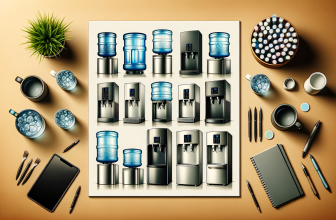
Are you on the search for the perfect iron to support your quilting passion? Quilting is not only an art but also a precise craft that demands the right tools to bring your creative visions to life. An essential accessory in this process is the iron which is used to press fabrics, create crisp seams, and ensure a flawless finish. However, selecting the right iron for your quilting projects can be daunting, given the multitude of options available. This comprehensive review will guide you through the best irons for quilting, making it easier for you to make an informed decision.
Our Top Picks
Whether you’re a seasoned quilter or just starting out, you need an iron that you can rely on. After extensive research and considering feedback from the quilting community, here are our top five irons that stand out for their performance, features, and reliability.
Our #1 Top Pick: Rowenta DW5080 Focus
The Rowenta DW5080 Focus boasts a stainless steel soleplate with 400 micro steam holes that provide even steam distribution for a perfectly pressed fabric. It has a precision tip for those hard-to-reach areas, which is ideal for intricate quilt patterns. With its auto shut-off feature and anti-calcium system, this iron is built for both safety and durability. The 1700 watts of power ensure that the iron heats up quickly and stays hot, an essential feature for long quilting sessions.
Pick #2: Oliso TG1600 Smart Iron
The Oliso TG1600 Smart Iron offers a patented iTouch technology, which automatically lifts and lowers the iron, reducing strain on your wrists and making it a breeze to use. This feature is not just innovative but particularly useful when working through the many layers of a quilt. It has a stainless steel soleplate with a chromium finish to help it glide across fabrics smoothly. With 1800 watts of power and a 30-minute auto shut-off, it marries safety with high performance.
Pick #3: Panasonic 360° Freestyle Cordless Iron NI-WL600
Cordless irons can be incredibly convenient for quilters, and the Panasonic 360° Freestyle is a game-changer. It provides the freedom to iron in any direction without the hassle of a cord. This iron features a double-tipped soleplate, which is excellent for getting into tight spaces. The adjustable steam and dry heat options make it versatile for different fabric types. Plus, its detachable water tank makes refills simple and mess-free.
Pick #4: CHI Professional Steam Iron
CHI is a renowned brand for hair styling tools, and their expertise in heat technology translates well into their Professional Steam Iron. The CHI iron has over 300 steam holes, delivering powerful steam for a crisp finish. It includes a titanium-infused ceramic soleplate that resists scratching and has unique temperature control options suitable for all sorts of textiles used in quilting.
Pick #5: BLACK+DECKER Digital Advantage Professional Steam Iron
For those looking for a perfect blend of quality and affordability, the BLACK+DECKER Digital Advantage Iron is a strong contender. Its digital temperature control display eliminates any guessing game, providing precision for your quilting requirements. With its stainless steel soleplate and a high steam rate, it smooths out wrinkles effortlessly. The three-way auto shut-off adds a layer of safety that is much appreciated.
What to Know Before You Buy
Before diving into your purchase, it’s crucial to consider the different aspects of what makes an iron suitable for quilting:
– Steam Output: The amount of steam an iron can generate is critical for pressing quilting fabrics. Look for irons with adjustable steam settings.
– Soleplate Material: A smooth soleplate helps the iron glide across your quilt with ease, preventing snags and pulls.
– Temperature Control: Different fabrics used in quilting require different heat settings. Precise temperature control is a must.
– Weight: Heavier irons can press seams without extra effort, but they can also cause fatigue. Find the right balance for you.
– Cordless vs. Corded: Cordless irons offer mobility, whereas corded irons provide consistent heat. Decide based on your quilting habits.
– Size of the Water Tank: A larger water tank means fewer refills during extensive quilting tasks.
– Safety Features: Auto shut-off features can prevent accidents, especially during long quilting sessions.
Factors to Consider Before Buying
When purchasing an iron for quilting, you’ll want to weigh these factors to ensure you pick the best tool for your needs:
– Durability: Quilting requires frequent iron use, so you need a product that can withstand the wear and tear.
– Comfortable Handle: Since quilting involves a lot of ironing, an ergonomically designed handle will reduce hand strain.
– Precision Tip: Detailed quilting work often means getting into small spaces, so look for an iron with a precise tip.
– Easy-to-Fill Water Reservoir: You don’t want to be fumbling around trying to refill your iron; ease of use is key.
– Vertical Steaming: This feature allows you to steam fabrics while they hang vertically, a helpful bonus when working on large quilts.
Why Trust ChooseRight?
ChooseRight takes the guesswork out of selecting the best iron for quilting. Our reviews are based on comprehensive research that includes scrutinizing thousands of customer reviews and seeking feedback from professionals in the quilting industry. We’ve tested numerous models for efficiency, ease of use, and durability to ensure our recommendations meet high standards. Trust us to guide you to the iron that will best suit your quilting journey.
Finishing Thoughts
Selecting the ideal iron for quilting comes down to your individual needs, the types of quilts you enjoy making, and the features that will make your quilting process smoother and more comfortable. Consider the irons that made it to our top picks as a starting point in your quest for the perfect quilting companion. Remember to assess the critical factors and arm yourself with knowledge before making your final choice. With the right iron in your hand, your quilting artistry will undoubtedly reach new heights of precision and beauty.
Frequently Asked Questions
What features should I look for in an iron for quilting?
When shopping for an iron for quilting, you should look for features such as adjustable temperature settings, a reliable steam function, a precision tip for getting into tight spots, a larger water tank, and an auto-shutoff feature for safety. It’s also helpful if the iron has a good weight to it to help press fabrics without excessive force.
Do I need a steam iron for quilting?
A steam iron can be very useful for quilting as it helps to remove wrinkles and create crisp seams. However, some quilters prefer dry ironing for certain types of fabric or techniques. Ultimately, whether you need a steam iron will depend on your personal preference and the specific requirements of your project.
What is the difference between a quilting iron and a regular iron?
Quilting irons typically have additional features suited for quilting needs, such as a larger pressing surface, more accurate temperature controls, and a more powerful steam burst. They often also have ergonomic designs to reduce hand fatigue during long quilting sessions.
How much should I expect to spend on a high-quality iron for quilting?
High-quality irons for quilting can vary widely in price, ranging from around $30 to over $200. The cost typically depends on the brand, features, and the iron’s performance. Investing in a mid to high-range model can be worthwhile for frequent quilters in need of a reliable and efficient tool.
Can I use a mini iron for quilting?
Mini irons can be used for quilting, especially for appliqué work, tight spaces, or small projects. While they don’t replace a full-size iron for larger tasks, they are a handy complement to your quilting toolkit for detailed work.
Is a cordless iron good for quilting?
A cordless iron can provide the convenience of maneuverability and ease of use, which is great for quilting. However, you might need to consider its heat retention capabilities and recharge frequency, as you would generally require consistent heat for larger quilting projects.
What is the best way to clean my quilting iron?
To clean your quilting iron, refer to the manufacturer’s instructions, as different irons have different requirements. Generally, you can use a damp cloth for the exterior and a vinegar solution or a commercially available iron cleaner to remove buildup from the soleplate. Always ensure the iron is cool and unplugged before cleaning.
How often should I replace my quilting iron?
The lifespan of a quilting iron varies based on usage, quality, and maintenance. With proper care, an iron can last several years. Signs that you might need to replace your iron include consistent temperature problems, leaking, or failure to heat up.
Are there any safety concerns I should be aware of when using an iron for quilting?
Yes, always follow safety guidelines such as using the correct voltage, not leaving the iron unattended when it’s on, never filling the iron with water when it’s plugged in or hot, and using the auto-shutoff feature if available. Also, be cautious not to burn yourself or your fabric, and ensure your ironing area is stable and heat resistant.







